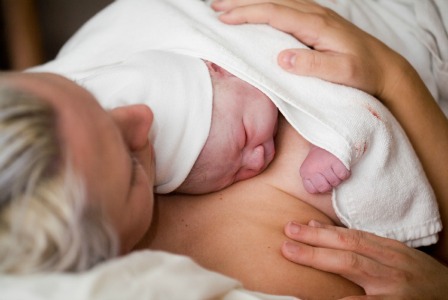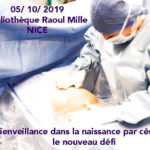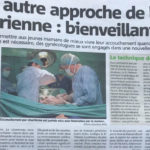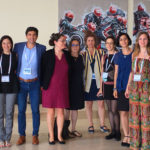The benevolent approach to C-section is a procedure in which every effort is made to limit the trauma associated with C-section delivery and promote bonding between mother and baby. This philosophy has given rise to a benevolent C-section that allows the patient to quickly regain autonomy and responds as closely as possible to the emotional and physiological needs of the mother and newborn. It is based on three elements: an innovative C-section technique known as the FAUCS technique, active maternal pushing with a blower, and early skin-to-skin contact in the operating theatre in the presence of the father.
What is FAUCS (pronounced ‘fox’)?

FAUCS, which stands for ‘French AmbUlatory Cesarean Section,’ is a C-section technique developed in France by Dr. Denis Fauck. Based on reduced anaesthetic doses and less invasive surgery, this technique allows patients to take care of their babies sooner after their C-section. Still largely unknown to the general public and doctors, it is now practised in a few private clinics (see the list of doctors practising this technique on the website www.cesarienneextraperitoneale.fr). Having reached maturity, the procedure has recently been the subject of national and international training courses (Paris, Tel Aviv, Tunis).
What are the specific features of the FAUCS technique?
Firstly, as the C-section technique is less painful, the doses of anaesthetic administered at the start of the procedure are much lower than those administered for a conventional C-section. The anaesthesia, which affects the area from below the navel to the toes (spinal anaesthesia), is also short-lived. As a result, the patient can get up and walk after 2-3 hours, urinate normally without a catheter in the bladder, and eat or shower as soon as they feel the need.
From a surgical point of view, as with any modern C-section, the skin is incised horizontally across the lower abdomen just above the pubic bone, measuring 9-10 cm. The technique then differs greatly from a traditional C-section. First, the obstetric surgeon makes a vertical incision in the rectus sheath (a very resistant membrane that acts as a natural sheath for the abdominal muscles) in the direction of the muscle fibres, whereas in a traditional C-section, this membrane is incised horizontally. Next, the muscles are spread apart manually. Finally, the peritoneum (a flexible membrane containing and protecting the intestines) is bypassed to access the uterus. By avoiding opening it, the organs are protected from any possible injury and irritation caused by the spillage of blood and amniotic fluid. The baby is delivered through a small incision in the uterus, which is closed with a pouch (as in heart surgery) to allow the uterine scar to retract better. The skin is closed using a glue that prevents infection, provides an optimal aesthetic result and avoids the inconvenience of removing stitches or staples.
How can the patient actively push during a C-section?

In general, patients who have had a C-section are unable to push effectively to deliver their baby as they would during a natural birth, for two reasons. The first is related to local anaesthesia (spinal or epidural anaesthesia, depending on the case, as general anaesthesia has become rare): the patient has absolutely no feeling in her abdominal muscles and is not trained to use them without feeling them, so she appears to be ‘paralysed’ in this area. The second reason is that C-sections are often scheduled and performed without any labour contractions. Without contractions, there is no spontaneous pushing of the baby towards the exit. This is why, in order to deliver the baby, the obstetric surgeon performing the C-section is usually forced to press vigorously on the top of the patient’s abdomen to push the baby out. This is called abdominal expression. This technique was also often used in natural childbirth in the past. It is now prohibited because of its violence. Today, thanks to the invention of a French physiotherapist and the brilliant idea of Dr Bénédicte Simon, abdominal expression is no longer necessary during C-sections, allowing patients to play a full role in the birth of their babies. Luc Guillarme has developed a small plastic mouthpiece called the ‘Souffleur’ (blower) which is used for abdominal and perineal rehabilitation. The principle is as follows: by creating an obstacle to the patient’s exhalation while ensuring a linear breath, the patient can learn to effectively control her diaphragm, abdominal muscles and perineum. Used during a C-section, this allows the patient to push gradually and repeatedly, as in a vaginal delivery. A study begun in late 2017 at the Santa Maria Polyclinic Maternity Ward in Nice has already shown a very high satisfaction rate among the first 20 patients who used the Guillarme Blower, due in particular to its ease of use and their active participation in the expulsion of their babies.
What is early skin-to-skin contact?
 Early skin-to-skin contact involves placing the naked baby on its mother’s skin immediately after birth and leaving it there for as long as possible. This allows the physiological and emotional needs of newborns and their mothers to be met. The operating theatre environment must be adapted to ensure safety, but the benefits of skin-to-skin contact are so numerous that it is well worth the effort:
Early skin-to-skin contact involves placing the naked baby on its mother’s skin immediately after birth and leaving it there for as long as possible. This allows the physiological and emotional needs of newborns and their mothers to be met. The operating theatre environment must be adapted to ensure safety, but the benefits of skin-to-skin contact are so numerous that it is well worth the effort:
- Breathing: Studies show that newborns breathe more easily when placed skin-to-skin rather than separated from their mothers.
- Bonding: Immediately after birth, most babies are awake, can see well and, according to studies, have a visual preference: they want to see a face. ‘Preferably their mother’s!’ In addition, skin-to-skin contact increases the natural level of oxytocin secreted by the mother. This hormone promotes mother-child bonding.
- Natural incubator: Newborns need warmth immediately after birth. It has been shown that their temperature is maintained just as well through skin-to-skin contact as in an incubator.
The presence of the father
 Today, only a third of French maternity wards allow fathers to attend C-sections, even though the vast majority of patients want their partners by their side to welcome their babies into the world. By allowing fathers to be present in the operating theatre, the team enables patients to feel reassured, supported and accompanied by the person closest to them, with whom they have shared the entire experience of pregnancy. When the baby is born, it is welcomed by both parents. This approach contributes to the psychological and emotional well-being of all three.
Today, only a third of French maternity wards allow fathers to attend C-sections, even though the vast majority of patients want their partners by their side to welcome their babies into the world. By allowing fathers to be present in the operating theatre, the team enables patients to feel reassured, supported and accompanied by the person closest to them, with whom they have shared the entire experience of pregnancy. When the baby is born, it is welcomed by both parents. This approach contributes to the psychological and emotional well-being of all three.













Leave A Comment